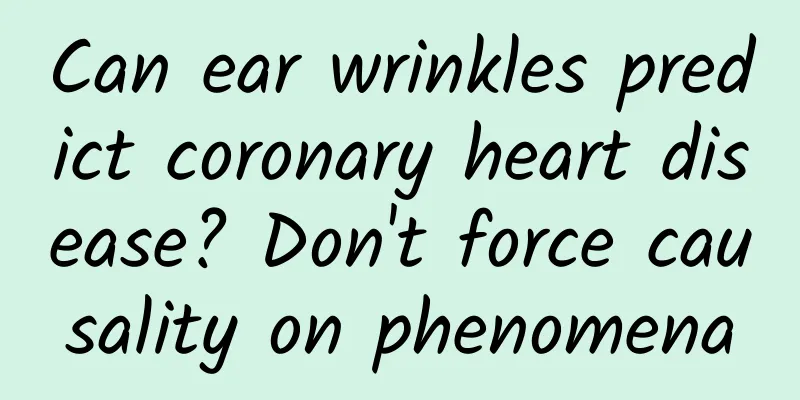Can ear wrinkles predict coronary heart disease? Don't force causality on phenomena

|
Sun Qiaolu, who played Ling Meiqi in "Balala the Fairies", passed away. Netizens discovered that she had earlobe creases, which also appeared on other stars such as Gao Yixiang and Wang Junkai. Does this indicate coronary heart disease? Written by reporter Lai Tianying Edited by Liu Zhao New Media Editor/Chen Xuanzhi Interview experts Wang Yun (Chief Physician of the Department of Cardiology, China-Japan Friendship Hospital) gossip Earlobe creases can predict atherosclerotic disease. the truth The earlobe is mainly composed of connective tissue, without cartilage or ligaments. Its blood supply comes from the posterior auricular artery and the anterior auricular branch of the superficial temporal artery. Local ischemia may cause contraction of the earlobe skin and form wrinkles. This is a normal physiological phenomenon and is not necessarily related to coronary heart disease. On the first day of the new year, Sun Qiaolu, who played Ling Meiqi in Balala the Fairies, passed away at the age of 25. The cause of death was suspected to be sudden death caused by myocardial infarction. Then on January 3, news broke that a 23-year-old female employee of a large Internet company died suddenly on her way home from get off work at 1:30 a.m. On the evening of January 5, the well-known fashion blogger "Yarlung Zangbo River Woman" died of cardiac arrest on a flight from Beijing to Shanghai. According to a post on a social platform, "Yarlung Zangbo River Woman" was only 27 years old this year; If we go back a little further, on July 19, 2020, Lai Bao, a young writer and well-known talk show comedian, died of a sudden heart attack at the age of 39... Acute myocardial infarction, an extremely dangerous disease, is increasingly "visiting" young people, which is regrettable and has attracted widespread attention from the public. Some careful netizens discovered that Sun Qiaolu has a defect on her ear, namely the crease of the earlobe. This is a condition that Gao Yixiang and other stars such as Wang Junkai also had. ▲ Netizens found that Sun Qiaolu, Wang Junkai, and Gao Yixiang all had creases on their earlobes (picture from the Internet) The earlobe crease, also known as the earlobe crease sign (ELC), was first proposed by Dr. Sanders T. Frank in the world's top medical journal "The New England Journal of Medicine" in 1973. The medical community calls it Frank's sign. The article points out that there is a significant correlation between the earlobe crease sign and coronary artery disease and other atherosclerotic diseases, and it is considered one of the signs for predicting atherosclerotic diseases. So, is the earlobe crease really a sign of coronary heart disease? Can coronary heart disease be predicted in advance from the ears? ◆ ◆ ◆ Earlobe creases not necessarily linked to coronary heart disease The earlobe is mainly composed of connective tissue, without cartilage or ligaments. The wrinkles on it all start from the tragal notch, run horizontally or obliquely posteriorly to the outer lower edge of the earlobe. Most of them are linear or arc-shaped, and a few are S-shaped. The blood supply of the earlobe comes from the posterior auricular artery and the anterior auricular branch of the superficial temporal artery. Local ischemia may cause contraction of the earlobe skin and form wrinkles. From an anatomical point of view, there is no necessary connection between earlobe wrinkles and coronary heart disease. ▲Earlobe wrinkles (picture from the Internet) In textbooks such as "Practical Internal Medicine" and "Cardiology", the relationship between earlobe folds and coronary heart disease is rarely recorded. To this day, earlobe folds have not been included in the diagnosis and treatment guidelines for coronary heart disease at home and abroad, expert consensus, and medical textbooks, which shows that the guiding significance for doctors is not very large. In addition, some studies have found that the mechanism of earlobe folds may also be related to special sleeping postures, genetic backgrounds, premature aging, oxidative stress, collagen degradation, etc., and the specific mechanism is still unclear. In addition, this survey is limited to a small range, and its authenticity needs further verification. In fact, regarding the earlobe crease sign, a media reporter interviewed Wang Zhishi, deputy chief physician of the Department of Cardiovascular Medicine at Nanjing Chest Hospital. Director Wang mentioned it. He believes: "It is indeed found clinically that some patients with coronary heart disease have earlobe crease signs, but the specific relationship between the two is still unclear. In the currently published studies, the specificity of the earlobe crease sign as a screening indicator for coronary heart disease is not high." ◆ ◆ ◆ Earlobe crease is a normal physiological phenomenon Wang Yun, chief physician of the cardiology department of the China-Japan Friendship Hospital, also said: "Earlobe wrinkle syndrome is a physiological factor. As people age, the skin above the earlobe gradually ages, and the collagen in the skin gradually decreases, which manifests as loose skin. After the skin becomes loose, wrinkles are likely to appear. This is a normal physiological phenomenon." Regarding the relationship between earlobe wrinkles and coronary heart disease, Wang Yun continued to explain: "Some patients who suffer from coronary heart disease, myocardial ischemia and other heart diseases for a long time may have wrinkles on their earlobes, but it should be combined with the patient's clinical symptoms, as well as electrocardiogram, echocardiogram, coronary artery CT or coronary angiography and other related examinations. Earlobe wrinkles are just a physical phenomenon and cannot predict coronary heart disease." ◆ ◆ ◆ The diagnosis of coronary heart disease requires a combination of multiple testing methods After a lot of research, it was found that coronary heart disease is caused by atherosclerotic lesions in the coronary arteries, which cause vascular stenosis or blockage, resulting in myocardial ischemia, hypoxia or necrosis. In short, the blood vessels supplying the heart are narrowed, the heart is not supplied with enough blood, and the body shows a series of symptoms such as chest tightness and chest pain. According to the "Guidelines for the Primary Prevention of Cardiovascular Diseases in China": In addition to uncontrollable factors such as age, gender, and genetics, hypertension, dyslipidemia, diabetes, obesity and overweight, smoking, and poor eating habits are all independent risk factors for coronary heart disease. (Picture from the Internet) In addition, in clinical practice, cardiovascular doctors need to combine multiple test methods to diagnose whether a person has coronary heart disease, which is more reliable than the earlobe crease sign. Wang Yun said: "In clinical diagnosis of coronary heart disease, it is necessary to make a comprehensive judgment based on the patient's medical history, clinical symptoms, physical examination, electrocardiogram, echocardiogram, myocardial markers, coronary artery CT, coronary angiography and other related examinations." To determine whether a person has coronary heart disease, chest pain is the first clue that cardiologists obtain. Typical angina pectoris often presents as discomfort behind the sternum, which can be induced by fatigue or emotional excitement, and can be relieved by resting or taking nitrates. In some patients with coronary heart disease, abnormal local ventricular wall activity can be seen through echocardiography, and the patency of blood vessels can be visually observed through coronary artery CT examination. In addition, the most important coronary angiography is indispensable. It delivers the angiography catheter to the coronary artery orifice through the artery and directly injects contrast agent into the coronary artery. It can observe the patency of the coronary blood vessels from multiple angles. It is currently the most accurate diagnostic method and is known as the gold standard for the diagnosis of coronary heart disease. Therefore, in life, if you only have earlobe creases and no other discomfort symptoms, there is no need to worry too much. However, if we find that we have earlobe creases and have long-term independent risk factors for coronary heart disease such as hypertension, dyslipidemia, diabetes, obesity and overweight, we should go to the hospital for examination in time, make a reliable clinical diagnosis and rule out the disease. References: How is coronary heart disease diagnosed? You will know after reading this article http://ccm.dxy.cn/article/650158?trace=hot Can ear creases be used to diagnose myocardial ischemia in coronary heart disease? Rumor: It has little clinical value https://www.sohu.com/a/408529815_100155437 Hu Dayi. Research progress in diagnosis and treatment of coronary heart disease[J]. Chinese Journal of Cardiovascular Diseases, 2003, 31(11):806-811. Is a crease on the earlobe a "sign" of myocardial infarction? Rumor: There is a risk, but it should not be equated https://new.qq.com/omn/20210110/20210110A0A6V700.html Is it true that the crease on the ear can indicate heart disease? https://mp.weixin.qq.com/s/EHRyKfMO8qoBqV6Rg4xHXg Produced by: Science Central Kitchen Produced by: Beijing Science and Technology News | Science Plus Client Reproduction without authorization is prohibited, and offenders will be prosecuted |
>>: Is it okay to eat the bitter pomelo? When is the best season to eat pomelo?
Recommend
Nielsen: Weibo and TV programs influence each other
Social media and TV have a sweet relationship tha...
What shouldn’t pregnant women eat?
Nowadays, female friends must be very careful dur...
What color is Givenchy 334? Givenchy 2019 autumn and winter new product 334 lipstick color test
Givenchy 334 lipstick is a beautiful cherry color...
What causes coccyx pain in pregnant women?
As we all know, various functions of a woman'...
Can I wash my hair in the Qing Palace?
Many women have to undergo uterine curettage surg...
How do you know your breast shape?
We all know that breasts come in different sizes,...
Why are my nipples so itchy?
There are many reasons that can cause itchy nippl...
It is recommended that single girls read this article carefully! (Those who are already single should read this even more)
Appendix: References [1] Expert consensus on immu...
Where is the cheapest Maxmara coat? When is the best season to buy Maxmara coat?
MaxMara coats are super popular, and many people ...
What is the cause of vulvar itching and blood in vaginal discharge?
Women often have some secretions in their vaginas...
Women with cold uterus like to wear this thing
The characteristics of women with uterine cold re...
Is Ba Duan Jin a type of Tai Chi? What is the difference between Ba Duan Jin and Tai Chi?
Ba Duan Jin is an independent and complete set of...
Calf pain after menstruation
Menstruation is an "old friend" of ever...
What does it mean to dream of being bitten by a snake when pregnant?
Snakes are scary and frightening, and many women ...
How long does it take to get menstruation after miscarriage?
Having a child is a major event in a woman's ...









